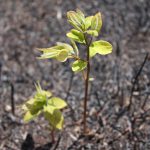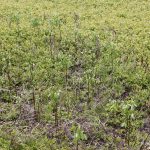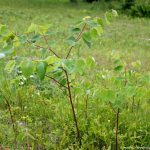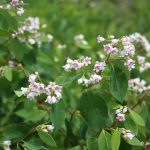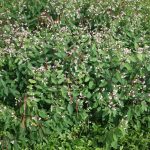Spreading dogbane
Prepared by Jennifer L. D’Appollonio, Assistant Scientist, University of Maine, Orono, ME 04469. Updated February 2018.
Scientific name: Apocynum androsaemifolium L.
Common name(s): spreading dogbane, fly-trap dogbane, bitterroot
Links: USDA PLANTS Profile , NPIN Profile, Go Botany
Images: (to see enlargements [PC]: click on image, then right click and choose “view image”)
- seedling in pruned blueberry field, mid-May
- Late May/early June with last year’s dead stems
- Spreading dogbane, June
- Spreading dogbane, June
- In flower, July
- Fruit and flower, late July
- Fruit detail
Description:
-perennial
-wide spread branching red stems
-can reach up to 2 feet tall
-leaves are opposite
-bell shaped flowers
spreads through patches of rhizomes
-contains a milky white sap that is toxic to humans
-generally flowers June through August in ME
Reddish stems 1′-4′ tall grow from horizontal rootstocks, branches smooth and spreading. Oval leaves opposite, 2″-4″ long and 1″-2.5″ wide, often drooping on short stalks. Flowers pinkish, bell-shaped and about 1/4″ wide, seed pods 4″ long and narrow, can be confused with bush honeysuckle. All parts exude white liquid when broken.
-may be confused with A. cannabinum; see left sidebar on Go Botany webpage
Habitat:
-disturbed areas
-road sides
-waste areas
Agriculture:
-produces nectar as an important food source
-attracts monarch butterflies
Natural History:
-native to North America
-genus “Apocynum” means “away from dog”
-its tough fibers were used to make threads and cords by Native Americans
-the root contains cymarin, a cardiac stimulant
Source(s):
Hansen, R.W., S.B. Hansen and E.A. Osgood. 1991. Reproductive phenologies of selected flowering plants in eastern Maine forests. ME Agric. Exp. Station Tech. Bull. 143. 17 pp.
Heinrich, B. 1976. Flowering phenologies: Bog, woodland, and disturbed habitats. Ecology. 57(5):890-899.
Greenlee, Jack. “Spreading Dogbane (Apocynum Androsaemifolium).” Plant of the Week, U.S. Forest Service, www.fs.fed.us/wildflowers/plant-of-the-week/apocynum_androsaemifolium.shtml.

